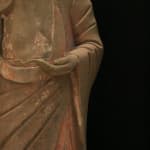Song Dynasty Standing Stone Buddha
Stone
height 153 cm
height 60 1/4 in
height 60 1/4 in
LI.3256
Further images
-
(View a larger image of thumbnail 1
)

-
(View a larger image of thumbnail 2
)

-
(View a larger image of thumbnail 3
)

-
(View a larger image of thumbnail 4
)

-
(View a larger image of thumbnail 5
)

-
(View a larger image of thumbnail 6
)

-
(View a larger image of thumbnail 7
)

-
(View a larger image of thumbnail 8
)

After the collapse of the Tang Dynasty (906 AD), there was a succession of short-lived governments (known as the Five Dynasties). This period of unrest came to an end with...
After the collapse of the Tang Dynasty (906 AD), there was a succession of short-lived governments (known as the Five Dynasties). This period of unrest came to an end with the establishment of the Song Dynasty in 960 AD. Renewed political stability helped to usher in a period of economic prosperity and a massive rise in population. Amongst the many cultural achievements of the Song Dynasty, the re-invigoration of the examination system and the invention of movable type rank highly. It was also the period which witnessed the development of Neo-Confucianism- a philosophical movement heavily influenced by Buddhist teachings. Although there is evidence that Buddhism had reached China from India during the Han Dynasty, it took time for the new faith to make progress. This was partly because it had to compete with native ideologies, namely Confucianism and Daoism. It was possible, however, to find common ground between these belief systems and by the Tang Dynasty Buddhism was experiencing a golden age in China.
It is extremely rare to find such a well-preserved Buddha dating to the Song Dynasty. he hair consists of small, finely carved, spiral curls which are arranged in regular horizontal tiers above the forehead, rising up into a mound that denotes the Buddha’s spiritual wisdom. The eyes are downcast with heavy, deeply cut eyelids. The expression is one of calm serenity and a meditative state. The elongated earlobes reference the historical Buddha’s life of luxury (the elongation was caused by wearing heavy earrings), before he set out of the path to enlightenment.
This sculpture is a unique object that recalls the piety of early Buddhists as well as the refined sensibilities of the Song era.
It is extremely rare to find such a well-preserved Buddha dating to the Song Dynasty. he hair consists of small, finely carved, spiral curls which are arranged in regular horizontal tiers above the forehead, rising up into a mound that denotes the Buddha’s spiritual wisdom. The eyes are downcast with heavy, deeply cut eyelids. The expression is one of calm serenity and a meditative state. The elongated earlobes reference the historical Buddha’s life of luxury (the elongation was caused by wearing heavy earrings), before he set out of the path to enlightenment.
This sculpture is a unique object that recalls the piety of early Buddhists as well as the refined sensibilities of the Song era.
96
of
96







